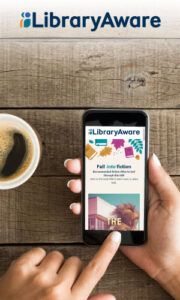
A perfect library experience is one where a kind, oracle of a librarian sees you struggling in the stacks, wandering up one aisle and down another in search of a new book. You don’t know what kind of book you want. You just know that you want it to be good, unlike anything you’ve ever read, life-changing. This is when the all-knowing librarian gracefully enters the scene with a perfect book. And poof! They’re gone again! You don’t know where the book came from and have never even heard of the genre, much less the author. Out of curiosity, you read the first page. Then the second. Next time you look up, you’re already 15 pages in. This is the one. Your life has been forever changed. Somehow, that magical librarian read your mind.
This is the kind of experience we librarians want all our patrons to have. Okay, not exactly like this with the mindreading and the teleporting. We want to appear as magicians, manifesting your next favorite read seemingly out of thin air. Unfortunately, recommending books to readers doesn’t always feel like this. The interactions can be awkward and the pressure is real. It takes time and dedication to advise readers on their next book. More than just reading widely, the advisor needs to be familiar with books outside their preferred genre. Plus, they need to know how to understand a patron’s reading tastes in just a few questions.
What Is Readers Advisory?
One of the best definitions I’ve found for Readers Advisory (RA for short) is from the Maine State Library website: “Simply put readers’ advisory is helping our customers find the best, most enjoyable reading experience that matches their needs, interest and reading levels. It is finding the right book at the right time.”
It’s one of the great joys of being a librarian. Arguably, many of us got into this work for exactly this reason. Matching books to their readers is one of the delights of my life. Especially when a reader returns to let me know how much they enjoyed the book I suggested to them, it warms my heart that they have a chance to read a great book for the first time.
Tips & Tricks
First and foremost, it’s important to note here that you don’t have to have read a book to recommend it. Hold all gasps until the end, please. Being well-versed in current titles doesn’t only mean being well-read. It also means that you spend time researching trends, listening to colleagues’ recommendations, and paying attention to which books are being checked out most frequently.
Ask questions. Starting with a simple, “Do you know what kind of book you are looking for?” opens a door for conversation. For many, this is all they need. For others, it’s an intimidating question. Readers aren’t always good at articulating what it is they like about a book., but they are usually great at explaining why they hated a book. Trying a question like “What was the last book you hated?” can open a dialogue for those struggling to decide. You’ll also get some readers who know exactly what they are looking for (looking at you, genre readers!) and come with a list of tropes they like, making book selection for that person much easier.
Match vibes. Readers like books because of how they make them feel. When you’re especially stuck on a suggestion, asking readers what they liked about the book rather than what the book was about can help you find another title for them. If they liked Talia Hibbert’s Brown Sisters series because of the representation of neurodiverse characters, then you might suggest The Luis Ortega Survival Club. On the surface, these books don’t have much to do with each other, and are in different genres—adult romance and YA realistic fiction. But what they do have in common are main characters with differently-abled brains narrating their own stories. The second book is a good suggestion because of the vibe.
Watch judgemental language. We all have preferences and opinions. The chances of you needing to recommend in a genre you don’t particularly like are 100%. Do not let your negative opinions of a genre, author, or trope keep patrons from checking out books and reading. Sometimes we may not even realize this is what we’re doing because judgmental language can sneak out in a “oh, you like him?” or “I could never,” etc. Be aware of what is said because if it’s the reader’s favorite, quick, thoughtless comments like these can shut down your credibility and rapport with patrons.
Diverse books. A quick and easy way to recommend books to people, especially those books outside your specialty or personal reading interest, is to offer another book in the same genre by a diverse author. BIPOC, disabled, neurodiverse, and LGBTQIA+ authors are underrepresented and under-marketed. The chances of your patron loving a book in the same genre are high. And unfortunately, so is the possibility that they don’t know about the author you’re going to recommend. Not only does this help people read more widely, but it also helps books by diverse authors get the attention they deserve.
Pair similar authors. Along the same lines as recommending diverse books within the same genre is keeping a running mental list of popular authors that people tend to check out together. It’s also a quick way to advise a reader. If a reader loves James Patterson, for example, I know I can recommend a James Moseley book that the reader will enjoy. If the reader is looking for more like Leigh Bardugo, I’m confident in a Sabaa Tahir recommendation.
Wild card. Always recommend more than one title and make sure that one of those recommendations is a little bit of a wild card. This is especially helpful for voracious readers. Throw in a book that you love and that has the same feel as some of the books the reader listed. Even if it seems completely off the wall, there’s a chance the reader will love it as much as you do. Again, this encourages patrons to read more widely and challenge themselves to try something new.
Give patrons space while you research. There are so many helpful tools for people looking to up their readers’ advisory skills. Book Riot writer Rachel Rosenberg wrote a piece about the best resources for RA that is excellent and full of useful links. If you’re trying to utilize these resources while actively helping a patron, it can get a little awkward for them to stand there while you search. Or vise versa. It can be just as awkward having someone watch as they browse the shelves while you rack your brain for a title to suggest.
Everyone in this scenario could use a little space. Let patrons browse while you research titles to recommend. This gives you time to focus on their request without the urgency of eyes on you. Then, you can pull a few books for them and let them review what you’ve selected on their own as well, so they don’t feel pressure to pick one of the books pulled for them. Creating a little space helps people breathe a little easier.
Tools
As I mentioned, there are a ton of resources to help improve RA skills. And Book Riot writers have done an excellent job rounding up resources, recommending less common RA tools, and the art of book recommendation. So you should check those out if you want more comprehensive lists. Meanwhile, here are a few of my favorites to help you on your RA journey.
- NoveList — a subscription database (available through many libraries for free!) designed to help match readers to books
- Literature Map — search for an author and Literature Map will suggest other authors you might like
- Fantastic Fiction — similar to NoveList, but free
- Goodreads — checking out a few 5-star and 1-star reviews helps me quickly get a feel for a book I haven’t read (or have read and forgotten the details of!)
- Epic Reads — as a high school librarian, these frequently updated themed book lists are an invaluable resource
- 10 Rules of RA Service — blogger and librarian Becky Spratford is a readers’ advisory specialist with years of experience and a comprehensive backlist of blog entries, including an RA “Greatest Hits” archive
No matter the kind of reader you’re trying to help, there should be something here that helps you help them.

